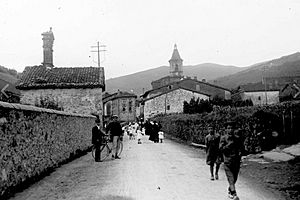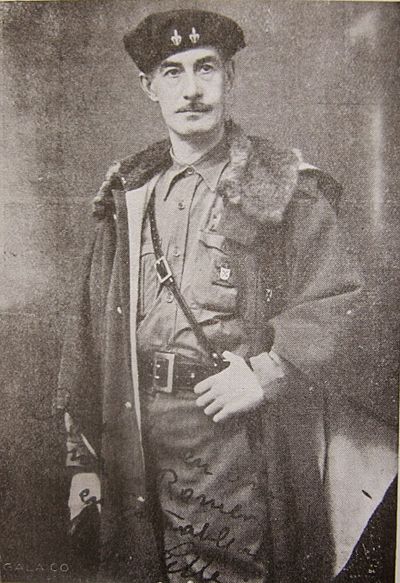Agustín Tellería Mendizábal facts for kids
Quick facts for kids
Agustín Tellería Mendizábal
|
|
|---|---|
|
|
|
| Born |
Agustín Tellería Mendizábal
1884 Antzuola, Spain
|
| Died | 1939 (aged 54–55) Vitoria-Gasteiz, Spain
|
| Nationality | Spanish |
| Occupation | entrepreneur |
| Known for | conspirator, industrialist |
| Political party | Carlism |
Agustín Candido Tellería Mendizábal (1884–1939) was a Spanish Basque politician and businessman. He supported the Traditionalist movement, especially Carlism. From 1933, he was part of the Carlist party leadership in Gipuzkoa.
Agustín Tellería is best known for his role in the plot against the Second Spanish Republic in 1936. As a businessman who supplied the army, he helped get weapons and ammunition for those planning the uprising. In 1937, he briefly led the Francoist state party, FET y de las JONS, in Gipuzkoa. However, he was removed because he was a strong Carlist and didn't fully agree with the new government's ideas.
Contents
Agustín Tellería's Early Life

The Tellería family, originally from the Basque region, has been in Antzuola since the 1700s. Agustín's great-grandfather was Silvestre Antonio Tellería Ugalde. His grandfather, Miguel Ignacio Telleria Lascurain, had at least nine children.
Agustín's father, Jose Cipriano Telleria Oyarzabal (1849–1938), married twice. His second wife, Maria Esteban Mendizábal Elgarresta, was Agustín's mother. The family was quite wealthy.
Antzuola was a center for tanning (making leather) in the late 1700s. Agustín's father owned a successful tanning factory. It made leather goods like belts, shoes, and holsters, mostly for the army. Agustín grew up with a lot of money.
It's believed Agustín studied chemistry or pharmacy. This is because his father's business involved chemicals. He was later called a "farmacéutico," which means pharmacist.
Agustín married Maria Legorburu before 1913. They lived in Antzuola and had at least ten children. One of his sons, José, became mayor of Antzuola and died in 1937 fighting in the war. Two other sons became religious leaders. His grandson, Ignacio, became a well-known doctor in Madrid.
Some of Agustín's grandchildren are also famous. Isabel Tellería Chávarri was a child movie star in the film The Spirit of the Beehive. Her sister Alicia works as a movie production manager. María Tellería Chávarri is a spokesperson for human rights groups in the European Union.
Joining the Carlists
The Tellería family had strong political beliefs, supporting the Carlists. Carlism was a traditionalist movement in Spain that wanted a different branch of the royal family to rule. Agustín's father was an officer in the Carlist army during the Third Carlist War. He remained loyal to their ideas even after their defeat.
Agustín followed his family's traditionalist views. In 1905, he and his family signed a message to Pope Pius X. This message protested against what they saw as masonic (secret society) influences in France.
In the mid-1900s, Agustín joined the Carlist youth group. He became the president of the group's branch in Tolosa. In 1908, he worked with Carlist leaders in Gipuzkoa. He helped organize a big Traditionalist meeting in Zumarraga. In the early 1910s, he was known for protesting to defend religion.
A Shift in Political Loyalty
In the late 1910s, the Carlist movement faced internal problems. There was a disagreement between a key thinker, Juan Vázquez de Mella, and the Carlist claimant, Don Jaime. Many Carlist leaders in Gipuzkoa supported Vázquez de Mella. He wanted a broad alliance of right-wing groups, with less focus on the royal family. Agustín Tellería agreed with him.
When the split happened in 1919, Agustín joined the group that broke away, known as the Mellistas. In late 1919, he ran for election to the Spanish parliament (Cortes) in San Sebastián as a Mellista candidate. It's not clear if he won or lost.
In the early 1920s, the Mellistas tried to build their own political group. Agustín remained loyal to them. By mid-1923, he was giving speeches at Mellista meetings in Gipuzkoa. He was one of the most recognized leaders in the province.
However, when Miguel Primo de Rivera took power in Spain, political activity largely stopped. Agustín's party work seemed to pause. During this time, he might have helped run his family's tanning company. He was also known as a "farmacéutico," suggesting he might have been involved in the pharmaceutical business.
Returning to the Carlists
After Primo de Rivera's government fell, Agustín Tellería became active in politics again. He focused on bringing all the Traditionalist groups back together. In early 1930, he organized a meeting in San Sebastián to call for unity.
In late 1930, the Mellista group in Antzuola decided to rejoin the Carlist party. They felt that their differences with Don Jaime were not about core beliefs. In April 1931, after the Second Spanish Republic was formed, Tellería signed a statement. It called for a common Basque-Navarre group to protect their historical rights.
In January 1932, Agustín was a main speaker at a big meeting in Pamplona. Here, the Traditionalist groups officially reunited. The new organization was called Comunión Tradicionalista. Tellería joined the Gipuzkoa leadership. He also became part of the national leadership. He was put in charge of building up the Carlist paramilitary group, the requeté, in the Basque-Navarre region.
He was very active in spreading the Carlist message. He gave speeches in many places. However, there were some doubts about how effective he was in his military role. In 1933, he was relieved of his duties in Navarre.
In October 1933, Tellería joined the Gipuzkoan party executive. He continued his propaganda work. He also ran for parliament in 1933 but did not win, even though he received many votes. In 1934–1935, he kept working for the party, speaking to large crowds and writing for Traditionalist newspapers. He supported the new Carlist leader, Fal Conde, who emphasized discipline and loyalty.
Agustín Tellería's Role in the Conspiracy
After the Popular Front won the election in February 1936, the Carlists were ready to overthrow the republican government by force. The party leaders were divided on how to do this. Some wanted a Carlist-only uprising. Others wanted to join the military if they decided to act. Tellería strongly supported the idea of a Carlist-only uprising.
He had some early talks with the Basque Nationalist Party about joining the plot. But his main job was to get supplies for the military. Since he owned the family tanning business and was known as a successful industrialist in Gipuzkoa, he was perfect for this role.
In March 1936, he arranged a trick. Metal products ordered for a fake customer in Bilbao were sent to Belgium. At the same time, 17 boxes with hundreds of pistols and rifles, made in the same factory and meant for Belgium, were delivered to Bilbao instead.
The Carlist plan included volunteers dressed as Guardia Civil (a Spanish police force) taking over government offices in Madrid. Tellería made sure the uniforms were ready. In early March, as an official supplier of leather goods for the army, he arranged for hundreds of Guardia Civil uniforms to be sent from Zaragoza to a Carlist storage place in Madrid.
The republican security services found out about the plan. They quickly identified Tellería as a key person behind it. He was arrested in May or early June. The Carlist plan had to be stopped.
Tellería was moved between prisons in Pamplona, Zaragoza, and Madrid. He claimed he was innocent. He said he thought the uniforms were for Spanish troops in Africa. He was in the Modelo prison during the July 1936 uprising. He survived a deadly fire at the prison and many raids by militias. During a quick trial, he pretended to be a Basque nationalist guilty of small crimes. This worked, and he was set free in late August.
He spent the next three months hiding in Madrid with friends and relatives. He used a false name and even pretended to be a member of the CNT (a workers' union). In early November, he managed to get a passport in Valencia. This allowed him to travel legally to France. He then went to Saint-Jean-de-Luz, where he met the Carlist regent, Prince Xavier of Bourbon-Parma. By mid-November, he was back in Antzuola, which was now controlled by the Carlists.
Between Carlism and Francoism
In December 1936, the Carlist war leadership, led by Fal, appointed Tellería as one of two "inspectores jefe de servicio." This was part of a plan to start a Carlist-only military academy. He also returned to his pre-war role as the Carlist leader in Gipuzkoa. His family's factory in Antzuola now produced goods for the Nationalist war effort. In early 1937, he published a booklet about his time in the Republican zone.
In March 1937, a Republican court in Bilbao found Tellería guilty of rebellion and sentenced him to prison. His son, who had died in action a month earlier, received the same ruling.
Agustín Tellería's views on Franco's push to unite the Carlists with the Falange (another political party) are not entirely clear. Some historians say he was a "posibilista Carlist," meaning he was open to compromise. However, in late March 1937, during heated Carlist debates, Tellería seemed to support the hardline Falcondistas. He questioned the legality of a group formed by other Carlists who wanted to weaken Fal's power.
After the forced unification of the parties was announced, Tellería saw a parade of Carlist and Falangist youth. He said it was "shameful" and "intolerable." He then went to meet Rodezno, another Carlist leader. He came back excited, believing that the Carlists should join forces with the military. He strongly recommended this to the Carlist regent, Don Javier.
In late April 1937, Tellería was appointed the first provincial leader of the unified Falange Española Tradicionalista in Gipuzkoa. In this role, he tried to ignore the Falangists and promote Traditionalism. He tried to make the first anniversary of the Nationalist troops taking San Sebastián into a big Carlist celebration.
However, his actions were reported to Burgos, the Nationalist headquarters. An "inspector nacional" and "inspector general" of FET investigated. In early September, Tellería was quickly removed from his position before the anniversary celebrations.
Despite this, Tellería did not completely lose favor. In October, he was allowed to give a radio speech as a former delegate. In early 1938, the military confirmed him as "inspector de las comisarías de Requetés," now formally under army command. Not much is known about his activities in this role.
On March 20, 1939, he lost control of his car on a slippery road near Vitoria. He survived the crash but died the next day in a hospital. His funeral was attended by important figures, including Rodezno, civil and military governors, and the mayor of San Sebastián.
Images for kids
-
Mellista meeting, around 1920
-
Guardia Civil, mid-1930s
-
Tellería posing as a CNT militiaman
-
requeté in San Sebastián, 1936
-
Tellería on the Northern Front, outskirts of Vergara, 1937
See also
 In Spanish: Agustín Tellería para niños
In Spanish: Agustín Tellería para niños









